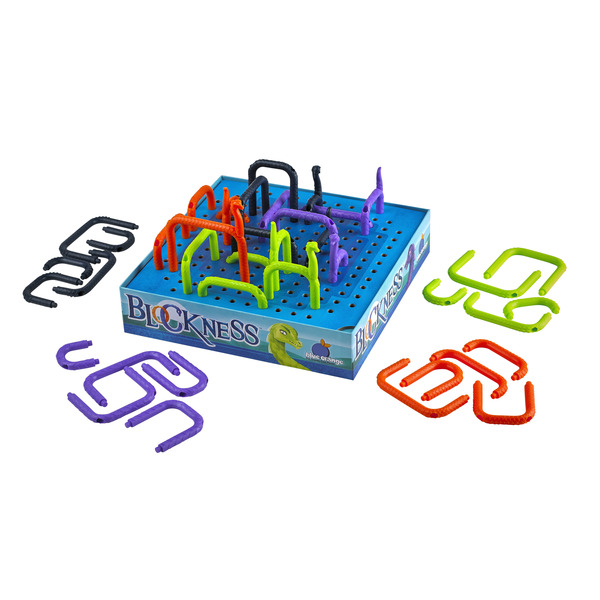Control the Lake By Building The Longest Block Ness Monster

Build your monster piece by piece, but watch out: space in the lake is limited and other players are vying for the same water.
A new fifteen-minute game from Blue Orange Games, Block Ness is a combination of tactile gameplay and area control.
Gameplay
The board shows a grid of holes. The more players in the game, the more of the board you use. At the start of the game, the board is placed into the game box, and each player takes the pieces of their monsters in their player color. The monster pieces include ten body segments (including one start piece) and one head and tail. The body segment pieces come in different heights and lengths and the two ends of each one fits into the holes in the board. There is also a hole at the end of each body segment to fit in the head and tail pieces.
Each player takes turns placing their start piece in the center of the board and places the tail at one end and the head in the other.
On your turn, you must add one of your monster’s body segments to the board. You must place it in an open hole in the board, and the hole must be one of the three holes adjacent to your monster’s head or one of the three adjacent to its tail. After placing the piece, you then move the head or tail (whichever one you built off of) to the far end of the new segment.
A couple of rules for placing a new piece: as long as the segment is taller, it may cross over any other segment (your own or an opponent’s). Even if it would be low enough to go under, you cannot build under another segment. Also, you cannot build a piece so that it crosses directly over a head or a tail. If that head or tail is moved on a future turn, then you can build over the space where it previously was. If you do not have a legal move, you must pass your turn.
Once no one can make another move, the game ends. The player with the fewest un-played segments wins the game.

Review
Block Ness is quite a simple game to learn. The rules are short and sweet. The most complicated aspect is a couple of rules regarding crossing over, which are quickly learned. It’s a very light game, but you still have interesting choices on your turn.
There is a nice balance, particularly as the game progresses and the board fills up, of trying to block off other players while still leaving yourself room to maneuver in the future. This comes through not only in the directions you build in and keeping an eye on both your monster’s head and its tail, but also in which heights and lengths of body segments you use and when.
The components are quite well made, with the monster pieces fitting into the board nicely, and the head and tails quite easy to put in and take out of the body pieces.
Block Ness is a fast playing game, coming in at about fifteen minutes. It’s at its best with three-to-four players, with that extra space to move around in and the extra strategy in choosing which players to prioritize when blocking. The tactile element is enjoyable, and it’s fun to see the board slowly fill up with the monsters.
Pros: Excellent component quality, tactile gameplay, simple rules
Cons: Player interaction isn’t quite as good at two players
Disclosure: we received a complimentary review copy of this game.






